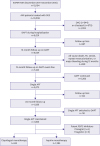INTRODUCTION
METHODS
Study population and data collection
 | Figure 1The study flow diagram of the patients.AMI = acute myocardial infarction; APT = antiplatelet therapy; DAPT = dual antiplatelet therapy; DES = drug-eluting stents; KAMIR-NIH = Korea Acute Myocardial Infarction Registry-National Institute of Health; MI = myocardial infarction; OAC = oral anticoagulants.
|
Clinical endpoints and definitions
Statistical analysis
Table 1
Baseline clinical characteristics

Table 2
Characteristics of index procedures and medical treatment at 12 months

RESULTS
Baseline clinical, procedural characteristics and medical treatment
Clinical outcomes
Table 3
Unadjusted and adjusted clinical outcomes at 24 months

 | Figure 2IPTW-adjusted cumulative incidence of NACE during the period from 12 to 24 months according to study group.IPTW = inverse probability of treatment weighting; NACE = net adverse clinical events.
|




 PDF
PDF ePub
ePub Citation
Citation Print
Print



 XML Download
XML Download